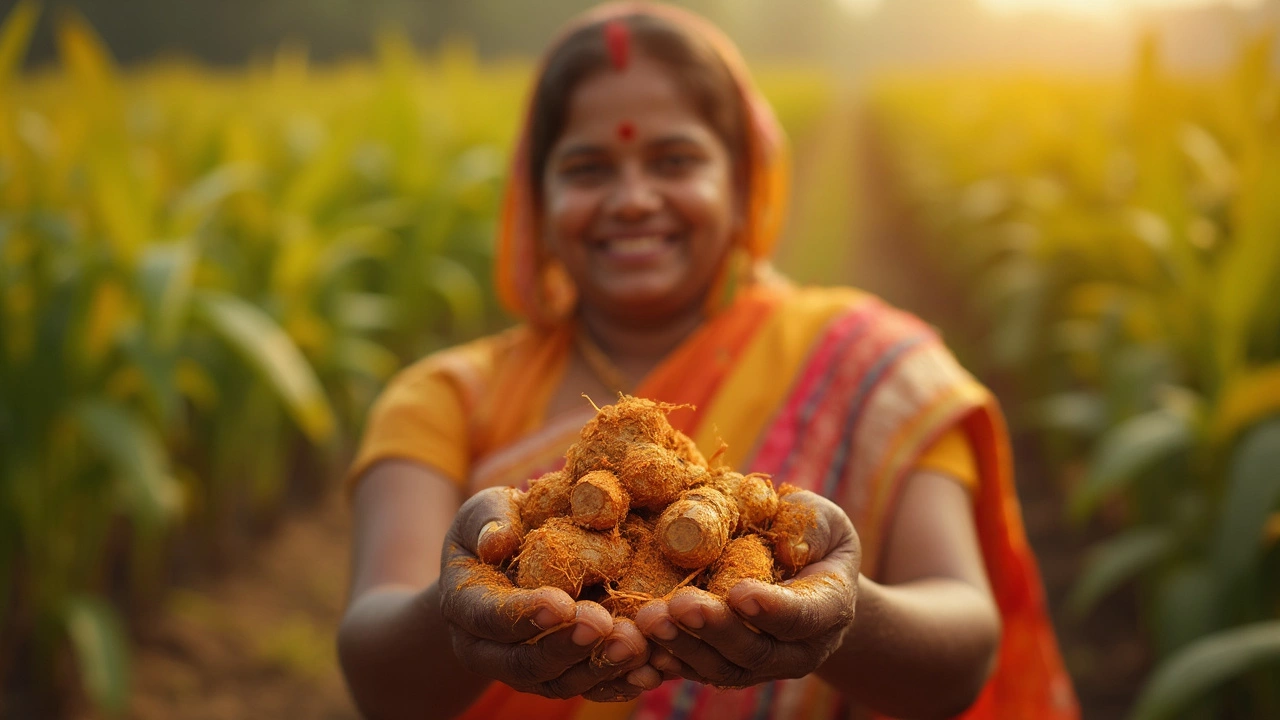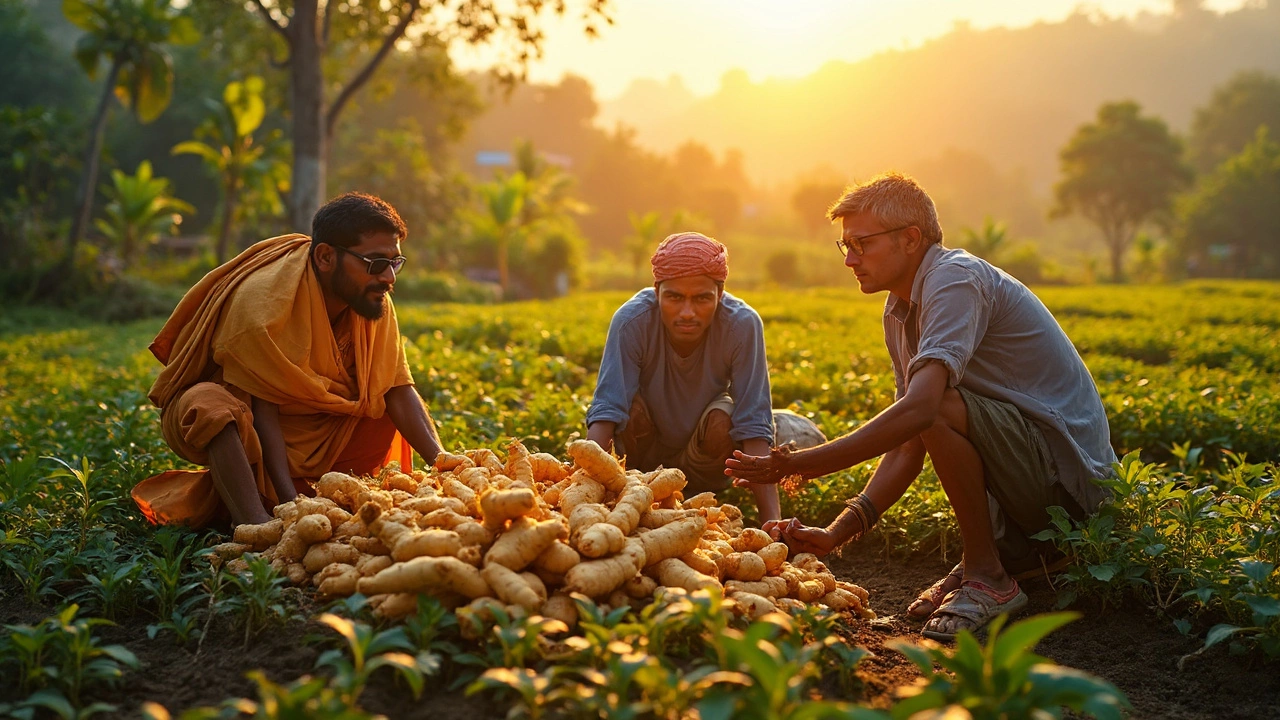If you’re after the most profitable plant in India, the answer might catch you off guard—it's bamboo. Forget fancy imported flowers or spice crops for a minute. Bamboo, that fast-growing “grass” you see by the roadside, quietly brings in serious cash for growers.
What’s so special about bamboo? It’s tough, grows almost anywhere, and matures quicker than most trees—some species shoot up a meter per day. That means short waits for profits. Plus, there's a huge market for everything bamboo makes: furniture, paper, construction, and even food. The Indian government is big on bamboo too, making it easier to grow and sell these days.
Before you start digging up your backyard, remember: profitability depends on timing, soil, local demand, and how smart you are about managing the crop. Gains are highest for those who know when and how to plant, and who keep an eye out for new opportunities—like eco-friendly products and value-added items.
- What Defines the 'Richest' Plant?
- Meet the Front Runner: Bamboo’s Surprising Fortune
- How Bamboo Became India’s Cash Cow
- Seasonal Profitability: Best Times to Plant
- Challenges and Tips for Growing High-Value Plants
- Other High-Earning Plants You Should Know
What Defines the 'Richest' Plant?
So what actually makes a plant the richest in India? It’s not just about how much it sells for per kilo. A "richest plant" is the one that fills growers’ pockets year after year. To figure this out, you’ve got to look at a few things: how fast it grows, what it costs to raise, how much you can harvest, who wants to buy it, and how steady the demand is. Plants that check all these boxes make the best money, hands down.
Let’s break down what matters the most:
- Market price: High market prices are great, but only if they’re steady.
- Growth speed: Crops like bamboo shoot up fast, so you don’t wait years to cash in.
- Low maintenance: If you’re not spending a bomb on fertilizers and labor, more of the cash stays with you.
- Demand and versatility: Plants used in lots of industries can ride out slowdowns in one market by selling in another.
- Seasonal adaptability: The best crops grow through most of the year, not just in one season.
Here’s a quick look at how some popular crops stack up:
| Plant | Time to Harvest | Market Price (per ton, INR) | Yield per Acre |
|---|---|---|---|
| Bamboo | 3-5 years | 60,000 - 100,000 | 15-20 tons/year |
| Sandalwood | 10-15 years | 1,500,000+ | 1-2 tons |
| Tea | 3-4 years | 120,000 - 180,000 | 2-3 tons/year |
| Rubber | 6-7 years | 100,000 - 130,000 | 2 tons/year |
Now, you might notice sandalwood’s crazy high price tag, but here’s the catch: it takes more than a decade to even start earning, and it's highly regulated. On the other hand, bamboo, our richest plant India keyword hero, grows fast, gives big yields, and is far less risky, making it the better bet for the long run.
Meet the Front Runner: Bamboo’s Surprising Fortune
Most folks don’t guess bamboo when they talk about the richest plant India has, but the numbers speak for themselves. Bamboo isn’t picky about where it grows—hills, plains, even the edge of your field. It’s fast, too. Some types can explode from seedling to harvest-ready in three years, which is rare for something harvested like timber.
Here’s the real kicker: bamboo is used everywhere. Need building material? Check. Furniture? Done. Toothbrushes, food, fences, musical instruments—the list goes on. Industries are hungry for bamboo, and as India plans more eco-friendly projects, demand is only going up. One acre of mature bamboo can fetch farmers between ₹1.5 to ₹3 lakh a year, depending on variety and market rates.
Check these hard facts about bamboo’s value:
| Aspect | Data |
|---|---|
| Growth Rate | Up to 1 m/day (some species) |
| Time to Maturity | 3-5 years |
| Average Yield/Acre (Yearly) | 10 to 15 tons |
| Income/Acre (Yearly) | ₹1.5 to ₹3 lakh |
| Main Uses | Construction, paper, handicrafts, food |
| Major Growing States | Assam, West Bengal, Karnataka, Kerala, Orissa |
Assam and West Bengal lead the way in bamboo production, but you’ll find big plantations in the south, too. The trick is to pick the right species for your region and sell smart. Farmers even rotate bamboo with other seasonal crops to keep land productive all year.
If you want in, start small. Connect with your local Krishi Vigyan Kendra or agriculture officer. Learn what grows best in your soil. Bamboo isn’t just about luck; it’s about using the right info and being ready to switch approaches as the market changes.
How Bamboo Became India’s Cash Cow
Not many people realize how quickly bamboo flipped the script in India’s rural economy. Back in the day, most farmers saw bamboo as nothing special—just a wild plant. But things started to change around 2017, when the Indian government rolled out the National Bamboo Mission. Suddenly, bamboo was no longer legally treated as a tree, which made it way easier to harvest, transport, and sell.
The numbers tell a wild story. India has more than 136 species of bamboo and covers almost 13% of the global bamboo area. By 2021, India’s bamboo business had crossed Rs 13,000 crore (almost $1.6 billion USD). Demand keeps climbing, not just for furniture and crafts but also for stuff like charcoal, paper, building materials, and fancy eco-products.
| Year | Bamboo Industry Value (in crore INR) |
|---|---|
| 2017 | ~4,385 |
| 2019 | ~8,000 |
| 2021 | ~13,000 |
What really sealed the deal was bamboo’s crazy growth rate. Some species shoot up so fast that you can harvest them every 3-5 years. Compare that to trees, which can take decades. So, when farmers look at what’s the richest plant India has to offer, bamboo’s short cycle and multiple uses make it stand out.
- One hectare can produce 20 to 40 tonnes of bamboo every year—worth lakhs of rupees with good management.
- Processing units are popping up fast in states like Assam, Madhya Pradesh, and Chhattisgarh, making it easier for farmers to get their bamboo to market.
- Demand for “green” material is booming: from toothbrush handles to eco-friendly homes, customers want bamboo stuff.
If you’re looking to cash in, remember it’s not just about planting bamboo. You’ve got to tap into value addition: products like bamboo plywood, flooring, and handicrafts fetch extra income. The bottom line? Bamboo’s speed, flexibility, and government support made it India’s cash cow in less than a decade.

Seasonal Profitability: Best Times to Plant
If you're considering growing bamboo, timing is everything for getting the best return. In most parts of India, the ideal window for planting bamboo is right before the monsoon—between late May and early July. The rainfall during monsoon helps the young plants set deep roots and kick-starts their growth. Skip this window and your bamboo could struggle, especially if you’re in north or central India where dry spells hit hard.
There’s a simple reason for this timing. Bamboo loves moist soil, but hates being waterlogged. So the start of the rainy season, when the ground gets a good soak but isn’t flooded yet, is perfect. In eastern and northeastern states like Assam or West Bengal, you sometimes get away with slightly later planting because the rains last longer.
If you’re serious about growing the richest plant India has to offer, don’t just plant any time you feel like it. Here are some quick tips for getting the timing right:
- Prep early: Get your land cleared and pits dug by April or early May. This avoids the last-minute rush and unpredictable weather.
- Pick healthy cuttings: Use one-year-old bamboo cuttings, which root best when planted right as monsoon begins.
- Mind the soil: Bamboo isn’t fussy, but slightly acidic to neutral soil works best. Make sure your patch isn’t in a low spot where rainwater pools for days.
- Spacing: Give each plant at least 4x4 feet if you want strong, sellable culms later on.
Getting the planting season right doesn’t just save you money—it makes you money faster since bamboo reaches maturity sooner and with fewer losses. If you’re farming in a region with erratic rains, seriously consider drip irrigation to help young plants along, no matter what the weather’s doing.
Challenges and Tips for Growing High-Value Plants
Growing what some call the richest plant India offers sounds tempting, but it’s not always a smooth ride. Even with profits on the horizon, there are real barriers you need to handle up front.
First, pests and diseases are troublemakers. For crops like bamboo, termites and fungal infections are your main enemies. Regular inspection and safe use of pesticides keep things under control. If you skip weekly checks, a problem can wreck months of work fast.
Then comes water. High-value crops often drink more than dryland varieties. Bamboo, for example, needs steady moisture, especially in the early years. Investing in drip irrigation or rainwater harvesting helps avoid drought stress. Watering the old school way with buckets just won’t cut it if you want consistent yields.
Market access can trip you up, too. A bumper crop doesn’t mean much if there’s no one to buy. The best growers make connections with buyers—paper mills, furniture makers, even online markets—before their crop is ready. Think beyond the local mandi. Some folks even create their own branded bamboo products to grab better margins.
- Test your soil before planting—nutrient balance matters for healthy growth.
- Pick good-quality seeds or saplings from trusted sellers. Don’t get fooled by low prices.
- Stagger your planting in small batches. This spreads risk and keeps harvests flowing longer rather than all at once.
- Stay updated. Training sessions run by agricultural universities or local Krishi Vigyan Kendras actually help. The best farmers keep learning all the time.
If you get these basics right, you give your investment a real shot. High-value plants can be a goldmine, but only when you stay sharp, work smart, and keep an eye on both the field and the market.
Other High-Earning Plants You Should Know
Bamboo may lead the pack, but it’s definitely not the only plant helping farmers and growers fill their wallets across India. Some crops have built entire local economies, and a few have even broken export records. Let’s break down some of these standout money-makers.
- Spices: Black pepper and cardamom sit at the top when it comes to cash crops in Kerala and the Western Ghats. Good quality black pepper can fetch over ₹500 per kilo. Cardamom, famously known as the "queen of spices," reached nearly ₹2,000 per kilo in recent years.
- Medicinal Plants: Ashwagandha, aloe vera, and tulsi (holy basil) are in constant demand thanks to India’s booming Ayurvedic and herbal wellness markets. Ashwagandha alone can bring in a steady income per acre if managed well.
- Horticultural Stars: Mango and pomegranate orchards can give returns for decades. Alphonso mangoes from Maharashtra bring premium prices, especially if you can sell directly or export. Pomegranate is gaining ground thanks to its popularity with urban buyers and international demand.
- Flowers: Marigold and rose farming is big business near most large cities. Marigold is super popular for festivals, weddings, and religious uses. Fresh roses, especially if you tap into the bouquet market, can be harvested multiple times a year for steady income.
- Oilseeds: Sesame and groundnut crops are good bets in states like Gujarat and Andhra. Sesame seeds are often exported, while groundnut is in high demand for edible oil production.
If you’re eyeing one of these high-value options, the key is to check local soil and weather, talk to buyers first, and start small. Strong networks with local markets or co-ops make selling easier—and usually bump up your profits. No matter which plant you pick, staying sharp on trends and being ready to adapt is the best way to beat the competition in the richest plant India game.





